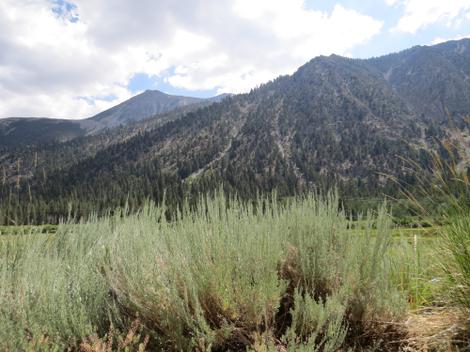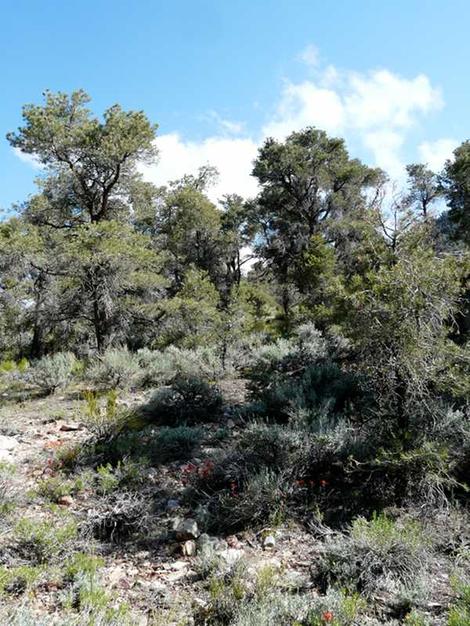Great Basin Sagebrush, Big Basin Sagebrush
Annual precipitation:
7-10 inches
Common Animals:
Sage Grouse, Sage thrasher, Horned lark, Common Raven, Red-tailed Hawk, Pronghorn, Black-tailed Jack Rabbit, Sagebrush defoliator moth,Great Basin Spadefoot Toad, Great Basin Rattlesnake and Great Basin Gophers snake
Common Plants:
Saltgrass (Distichlis spicata var. stricta), Leymus cinereus, Big Basin Sagebrush (Artemisia tridentata), Green Ephedra (Ephedra viridis), not very many plants for the public I'm afraid, think of Modoc county and N. Nevada.
Soil and climate notes:
An area where the ground can freeze most years to one to four inches. Frost can occur at most times of the year. Wonderful soils, high fertility, moderate alkalinity, crummy climate for all but the middle of summer. If you could do a 30 day vegetable garden you'd have it made. If you're planning a garden in this climate, have no illusions of 'making it work', it won't very well. Use plants that are native to the area or very similar areas.
The Great Basin Sagebrush plant community (floristic province) barely makes it into California along the northern California border with Nevada.
The wildlife is busy in a flurry of activity in summer. Fall is too dry; winter and spring too cold.
Cold, really cold or warm with swarms of mosquitoes. Sure is pretty though. The plant community is dominated by Big Basin Sagebrush (Artemisia tridentata) and different, rather ugly, twiggy Saltbushes (Atriplex spp.).
The book that represents this area is titled Intermountain Flora, by the New York Botanic Garden. Intermountain Flora shows a map of the Great Basin (Intermountain) extending from the northeast edge of California through Utah, south into Arizona and around Las Vegas, Nevada (Creosote Bush Scrub plant community) up into eastern Oregon and southern Idaho. The southwestern edge of Wyoming has a very little narrow “L” of the Big Basin Sagebrush plant community.We get occasional customers from these areas. Soil pH is commonly 8, sometimes 8.9. That's 100 times more alkaline than neutral. This plant community has a lot of drought tolerant plants that tolerate alkalinity, except along the creeks.
I imagine Munz didn't include this plant community in his “A California Flora' as it is very spotty in California and only is dominant in places like Bodie, California. Munz included a Sagebrush Scrub plant community which is hotter and more limited by hardpan than Big Basin Sagebrush.
Many ecologists include California's Sagebrush Scrub plant community in Great Basin Sagebrush. Intermountain Flora separates the two and is probably right. The Great Basin Sagebrush plant community is colder, harsher, and the growing season is later and shorter. The Sagebrush Scrub plant community usually has a faster -draining, less alkaline soil and you can grow some excellent commercial crops like apples. Apples in the Great Basin Sagebrush plant community are iffy at best. This also seems true for California native plants; many of the species that can exist in places like Frazier Park, Susanville, or the Alabama Hills cannot survive the colder winters in the Great Basin Sagebrush and the Great Basin Sagebrush plant species cannot survive the hotter, drier climate of the Sagebrush Scrub plant community.
The Antelope Bushes (Purshia spp.) seem to be indicator plants. Purshia tridentata lives in Great Basin Sagebrush, while Purshia glandulosa lives in Sagebrush Scrub. Hybrids of the two occur where their ranges overlap. Both species wander into the Pinyon-Juniper Woodland and even sometimes other close plant communities.
There are not many species in the trade from the Great or Big Basin Sagebrush plant community. Between the climate (the winter wind chill is amazing), lack of rain, not much fog, some bad soils (alkaline clays), the Great Basin Sagebrush plant community has islands of beauty and plant life spaced between vast areas of only three of four species of perennials. Annual wildflowers can be showy but very brief (a week).
Plants
A list of California native plants that grow in the Great Basin Sage plant community.








